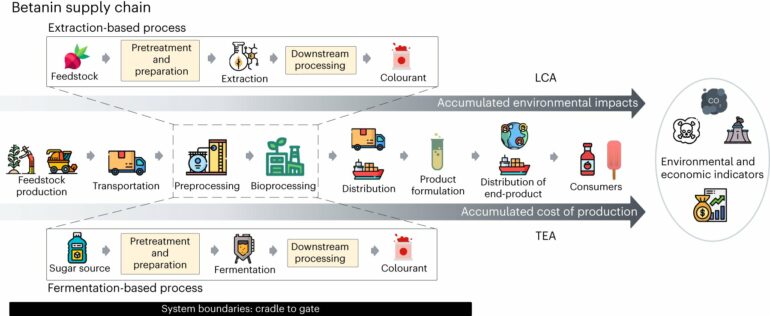Researchers from The Novo Nordisk Foundation Center for Biosustainability (DTU Biosustain) have developed an innovative fermentation process that produces natural betalain-type food colors. This groundbreaking technology is set to revolutionize the food color industry by offering a more sustainable and efficient alternative to traditional extraction methods.
The work is published in the journal Nature Microbiology.
Betalanins, which give red beets their distinctive hue, are commonly used worldwide in products ranging from meat substitutes to candies and ice creams. The most recognized of this group is betanin—a pigment that up until now is sourced from red beets. But the concentration of betanin in red beets is at approximately 0.2 % of the wet weight. This low content makes traditional extraction methods very wasteful.
“What’s truly revolutionary about our process is not just its sustainability and potentially lower cost, but also that you can obtain a product at a higher purity. While the beetroot extract contains sugars at high concentrations, our fermented product can be made sugar-free and thus can be made more concentrated. Furthermore, the current process presents a platform from which we can expand to making other betalanin-type colors, which are currently too expensive to be extracted from plants,” says Professor Irina Borodina.
The research group at DTU Biosustain, supervised by Prof. Borodina, used an oleaginous yeast commonly found in cheese, Yarrowia lipolytica, to achieve this feat. The team further performed metabolic engineering to optimize the cellular metabolism, ensuring enhanced color production and reduced by-products, thereby averting undesirable browning.
Can satisfy the world´s demand with just one-tenth of the equivalent land area
As part of the research project, researchers from the Sustainable Innovation Office at DTU Biosustain, provided a comprehensive life cycle assessment of the new fermentation process:
“Our findings indicate that the fermentation-based process uses significantly fewer resources, energy, and land when compared to traditional betanin extraction from beets. In effect, if we harness the potential of this fermentation-based color production fully, we can satisfy the world´s demand with just one-tenth of the equivalent land area,” says Dr. Sumesh Sukumara.
Further techno-economic evaluations indicate that fermentation-produced betanin could well be a feasible alternative in today’s market conditions. This opens up the potential for a broader palette of natural food colors, which are both more sustainably produced and potentially more affordable.
This new technology holds immense promise for various industries, including biotech, food color manufacturing, and metabolic engineering.
More information:
Philip Tinggaard Thomsen et al, Beet red food colourant can be produced more sustainably with engineered Yarrowia lipolytica, Nature Microbiology (2023). DOI: 10.1038/s41564-023-01517-5
Provided by
Danmarks Tekniske Universitet
Citation:
Nature’s palette reinvented: New fermentation breakthrough in sustainable food coloring (2023, December 1)



